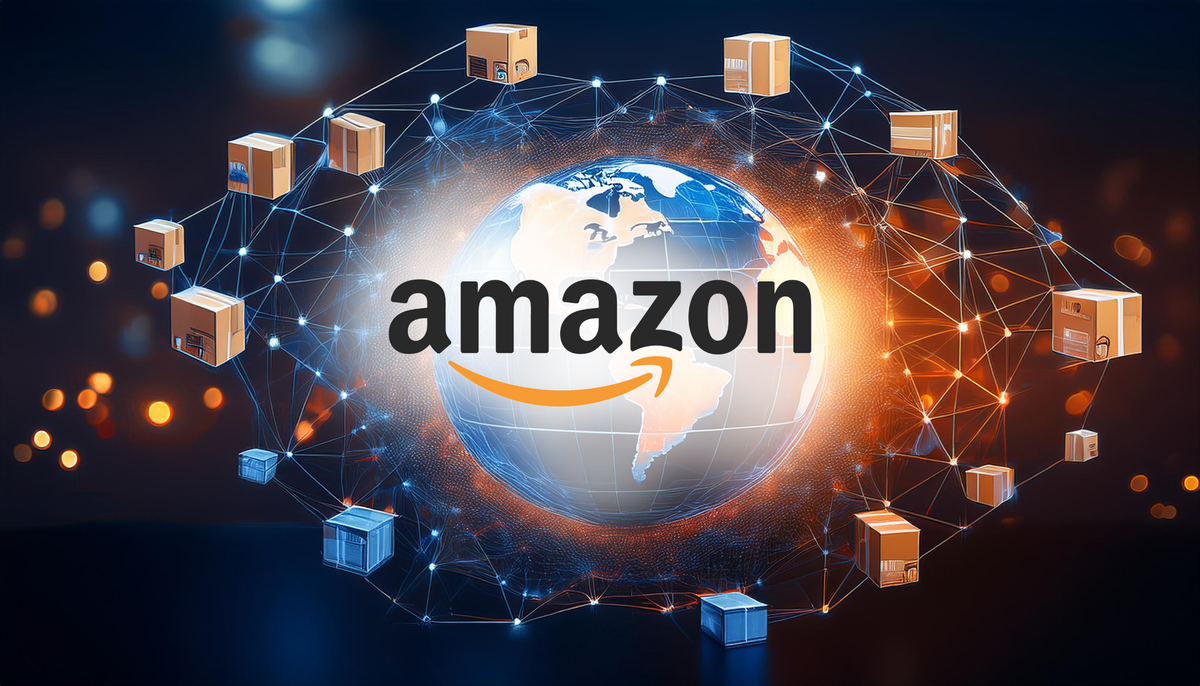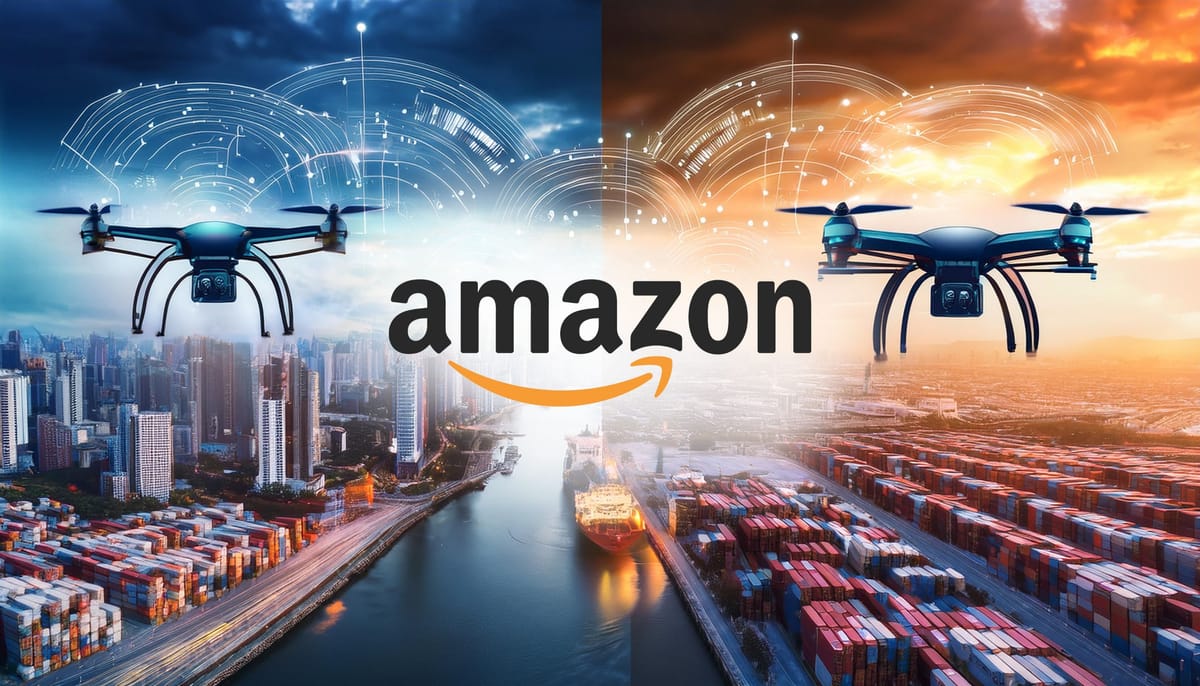When examining the e-commerce landscape, one cannot overlook the dominant force that is Amazon. The Amazon business model has revolutionized not only online retail but also numerous other industries. In this comprehensive analysis, we'll delve deep into the intricacies of Amazon's complex business model, exploring how this customer centric company has grown from a humble online bookstore to a global powerhouse.
The Evolution of Amazon: From Books to Everything Store
Founded by Jeff Bezos in 1994, Amazon began as an online bookstore but quickly evolved into what is now known as the “everything store.” This transformation is a testament to the adaptability and innovation inherent in Amazon’s business model. In recent years, Amazon has also ventured into physical retail with brick and mortar stores, comparing its traditional retail settings with its highly successful online sales strategy.
Bezos once famously stated, “Amazon is not too big to fail… In fact, I predict one day Amazon will fail. Amazon will go bankrupt. If you look at large companies, their lifespans tend to be 30-plus years, not a hundred-plus years.” This quote underscores a key aspect of Amazon’s culture: a relentless drive to innovate and stay ahead of the curve, which has been crucial to Amazon’s success.
Key Milestones in Amazon's Growth
- 1995: Amazon.com launches as an online store for books
- 1999: Expansion into music, videos, toys, and electronics
- 2002: Launch of Amazon Web Services (AWS)
- 2005: Introduction of Amazon Prime
- 2007: Release of the first Kindle e-reader
- 2014: Launch of Amazon Echo and Alexa
- 2017: Acquisition of Whole Foods Market, marking a significant entry into physical stores
- 2018: Surpasses 100 million Prime members globally
- 2020: Jeff Bezos steps down as CEO, Andy Jassy takes over
Each of these milestones represents a strategic move that has expanded Amazon's reach and capabilities. The company's willingness to enter new markets and disrupt existing ones has been a hallmark of its success.

The Four Pillars of Amazon's Business Model
The Amazon business model rests on four main pillars: e-commerce, cloud computing, digital streaming, and artificial intelligence. Let's examine each of these areas to understand how they contribute to Amazon's overall strategy.
1. E-commerce: The Foundation of Amazon's Empire
E-commerce remains the core of Amazon’s business, accounting for a significant portion of its revenue generated. The Amazon marketplace offers millions of products, from books and electronics to clothing and groceries.
Amazon’s e-commerce success is built on several key factors:
- Vast selection: Amazon offers an unparalleled range of products, often at low prices and competitive prices.
- Convenient shopping experience: Features like one-click ordering and personalized recommendations make shopping easy and efficient.
- Fast and reliable shipping: Amazon Prime‘s free two-day shipping (and in some cases, same-day delivery) has set a new standard for e-commerce fulfillment.
- Customer reviews: The ability for customers to leave reviews helps build trust and aids in purchase decisions.
Amazon’s commitment to customer satisfaction is evident in Bezos’s words: “We see our customers as invited guests to a party, and we are the hosts. It’s our job every day to make every important aspect of the customer experience a little bit better.”
However, it’s worth noting that Amazon’s dominance in e-commerce has not come without challenges. The company has faced criticism over its treatment of third party sellers, allegations of anti-competitive practices, and concerns about counterfeit products on its platform.
2. Cloud Computing: The Profit Engine
While e-commerce may be Amazon's most visible business, Amazon Web Services (AWS) is its most profitable. AWS provides on-demand cloud computing platforms to individuals, companies, and government agencies on a pay-as-you-go basis.
AWS has become a critical part of the internet's infrastructure, powering a significant portion of the web. Its success is due to several factors:
- First-mover advantage: AWS was one of the first major players in cloud computing, allowing it to build a strong market position.
- Scalability: AWS allows businesses to easily scale their computing resources up or down based on demand.
- Wide range of services: From basic storage and computing to advanced machine learning and analytics tools, AWS offers a comprehensive suite of cloud services.
- Reliability: AWS has built a reputation for high uptime and performance, critical for businesses that rely on cloud infrastructure.
Andy Jassy, who led AWS before becoming Amazon's CEO, once said, "There's no compression algorithm for experience." This quote reflects AWS's strategy of continuous innovation and improvement based on customer feedback and real-world experience.
The success of AWS has been a game-changer for Amazon's financials. In Q4 2022, AWS generated $21.4 billion in net sales, with an operating income of $5.2 billion. This high-margin business has allowed Amazon to invest heavily in other areas of its operations, even when those investments don't immediately generate profits.

3. Digital Streaming: Building the Entertainment Ecosystem
Amazon Prime Video, the company's streaming service, is a key part of the Prime membership program. While it may not generate significant direct revenue, it plays a crucial role in Amazon's ecosystem by increasing customer loyalty and engagement.
Prime Video offers:
- Original content: Amazon Studios produces award-winning original series and films.
- Licensed content: A wide range of movies and TV shows from other studios.
- Add-on channels: Users can subscribe to additional premium channels through Amazon.
Jeff Bezos once explained the strategy behind Prime Video: "When we win a Golden Globe, it helps us sell more shoes." This quote encapsulates how Amazon views its various services as interconnected parts of a larger ecosystem.
The streaming service faces stiff competition from Netflix, Disney+, and others. However, Amazon's ability to bundle it with other Prime benefits gives it a unique advantage in customer acquisition and retention.
4. Artificial Intelligence: The Future of Amazon
Artificial intelligence (AI) and Machine Learning (ML) are increasingly important to Amazon's operations across all its business lines. From product recommendations in e-commerce to voice recognition in Alexa devices, AI is at the heart of many Amazon services.
Key areas where Amazon is leveraging AI include:
- Personalization: Tailoring product recommendations and search results to individual users.
- Forecasting: Predicting demand to optimize inventory and supply chain operations.
- Alexa: Powering voice recognition and natural language processing in Amazon's smart devices.
- AWS AI services: Offering AI and ML tools to AWS customers.
Amazon’s Key Activities and Resources
Key Activities
Amazon’s key activities revolve around creating a seamless and personalized shopping experience for its customers. At the heart of these activities is the continuous development and maintenance of its e-commerce platform, which includes both its website and mobile app. This platform is designed to be user-friendly, efficient, and capable of handling millions of transactions daily.
Managing logistics and supply chain operations is another critical activity. Amazon has built an extensive network of fulfillment centers, sortation centers, and delivery stations to ensure fast and reliable shipping. This logistics network is a cornerstone of Amazon’s promise of quick delivery, especially for Prime members who enjoy benefits like free two-day shipping.
Investing in research and development (R&D) is also a key activity for Amazon. The company continually seeks to improve its products and services through innovation. This includes advancements in areas like artificial intelligence, machine learning, and automation, which help enhance the customer experience and streamline operations.
Building and maintaining relationships with third-party sellers and suppliers is essential for Amazon’s marketplace. These relationships enable Amazon to offer a vast selection of products at competitive prices. The company provides various tools and services to help third-party sellers succeed on its platform, fostering a mutually beneficial ecosystem.
Finally, providing exceptional customer service is a top priority for Amazon. The company offers multiple channels for customer support, including online chat, phone, and email. This commitment to timely customer service helps build trust and loyalty among its customers.
Key Resources
Amazon’s success is underpinned by several key resources. Foremost among these is its technological infrastructure, which includes data centers, servers, and sophisticated software systems. This infrastructure supports everything from e-commerce operations to cloud computing services offered through AWS.
Physical spaces are another critical resource. Amazon’s network of fulfillment centers, sortation centers, and delivery stations enables the company to store, sort, and deliver products efficiently. These facilities are strategically located to optimize delivery times and reduce shipping costs.
Human resources are also vital to Amazon’s operations. The company employs a vast workforce, including full-time employees and contractors, who work across various functions such as technology development, logistics, customer service, and more. Amazon’s employees are integral to its ability to innovate and maintain high service standards.
Brand recognition and reputation are invaluable assets for Amazon. The company’s strong brand is synonymous with convenience, reliability, and customer-centricity. This reputation helps attract and retain customers, as well as build trust with third-party sellers and partners.
Lastly, customer data and analytics are crucial resources. Amazon leverages data to personalize the shopping experience, optimize inventory management, and drive targeted marketing efforts. This data-driven approach allows Amazon to stay ahead of customer needs and market trends.
Amazon’s Key Partners
Amazon’s success is not achieved in isolation; it relies on a network of key partners who play crucial roles in its operations. One of the most significant groups of partners is third-party sellers. These sellers use Amazon’s marketplace to reach a vast audience, offering a wide range of products that enhance the platform’s diversity and appeal. Amazon provides these sellers with various tools and services to help them succeed, including fulfillment services, advertising options, and analytics.
Suppliers are another critical group of partners. They provide the products and services that Amazon sells directly to consumers. Maintaining strong relationships with suppliers ensures a steady supply of high-quality products, which is essential for meeting customer expectations and maintaining competitive prices.
Logistics providers are indispensable to Amazon’s ability to deliver products quickly and efficiently. These partners help manage the complex logistics of shipping millions of items to customers around the world. By working with a network of delivery services, Amazon can offer fast and reliable delivery options, including same-day and two-day shipping for Prime members.
Technology partners also play a vital role in Amazon’s ecosystem. These partners provide the software and services that support Amazon’s technological infrastructure, from cloud computing solutions to machine learning tools. Collaborating with technology partners allows Amazon to stay at the forefront of innovation and continuously improve its offerings.
Content providers are essential for Amazon’s digital streaming services, such as Prime Video and Amazon Music. These partners supply the movies, TV shows, music, and other content that Amazon streams to its customers. By securing licensing agreements and creating original content, Amazon can offer a compelling entertainment experience that enhances customer loyalty and engagement.
Amazon's Financial Performance: A Closer Look
Amazon’s financial performance has been impressive over the years, with consistent revenue growth and improving profitability. Online stores play a significant role in this, contributing over 40% to Amazon's total revenues. Let’s break down some key financial metrics:
Revenue Growth
Amazon's net sales have shown strong year-over-year growth. In Q4 2022, net sales increased 9% to $149.2 billion, compared with $137.4 billion in Q4 2021. For the full year 2022, net sales increased 9% to $514.0 billion, compared with $469.8 billion in 2021.
Profitability
While Amazon's e-commerce operations often operate on thin margins, the high-margin AWS business has significantly boosted overall profitability. In Q4 2022, operating income decreased to $2.7 billion, compared with $3.5 billion in Q4 2021. For the full year 2022, operating income decreased to $12.2 billion, compared with $24.9 billion in 2021.
Cash Flow
Amazon has consistently generated strong cash flows, which it reinvests in the business. For the trailing twelve months ended December 31, 2022, free cash flow was an outflow of $11.6 billion, compared with an inflow of $9.1 billion for the trailing twelve months ended December 31, 2021.
It's important to note that Amazon's financial performance can be lumpy quarter-to-quarter due to seasonal factors and heavy investments in growth initiatives. The company has historically prioritized long-term growth over short-term profitability, a strategy that has paid off in terms of market dominance but can lead to volatility in financial results.
Amazon’s SWOT Analysis
Conducting a SWOT analysis provides a balanced view of Amazon’s position in the market by identifying its strengths, weaknesses, opportunities, and threats.
Challenges and Opportunities
Despite its success, Amazon faces several challenges:
- Regulatory scrutiny: Amazon's size and market power have attracted attention from regulators concerned about anti-competitive practices.
- Competition: While dominant in e-commerce, Amazon faces strong competition in areas like cloud computing (from Microsoft and Google Cloud) and streaming (from Netflix and Disney).
- Labor issues: The company has faced criticism over working conditions in its fulfillment centers and delivery stations.
- International expansion: While successful in many markets, Amazon has struggled to gain traction in some large markets like China.
However, these challenges are balanced by significant opportunities:
- AI and automation: Further integration of AI could improve efficiency across Amazon's operations.
- Healthcare: Amazon's acquisition of One Medical signals its intent to disrupt the healthcare industry.
- Advertising: Amazon's advertising business is growing rapidly, leveraging its vast trove of customer data.
- Expanding AWS: As more businesses move to the cloud, AWS has room for continued growth.
Amazon's Business Model Canvas
To better understand the intricacies of Amazon's business model, let's break it down using the Business Model Canvas framework:
- Customer Segments:
- Individual consumers
- Businesses (B2B through Amazon Business)
- Third party sellers
- Independent software vendors (through AWS)
- Value Propositions:
- Wide selection of products at competitive prices
- Convenient and fast shipping (free two-day shipping for Prime members)
- Timely customer service
- Reliable cloud computing services (AWS)
- Entertainment (Prime Video, Amazon Music)
- Channels:
- Amazon's e-commerce platform (website and mobile app)
- Physical stores (Amazon Go, Whole Foods)
- AWS console
- Amazon Prime Video app
- Customer Relationships:
- Personalized recommendations
- Customer reviews and ratings
- Online chat and phone support
- Prime membership benefits
- Revenue Streams:
- Product sales (first-party)
- Third-party seller fees
- AWS subscription fees
- Prime membership fees
- Advertising revenue
- Key Resources:
- Technology infrastructure
- Fulfillment centers and logistics network
- Customer data
- Kindle devices and digital content
- Key Activities:
- E-commerce operations
- Cloud computing services
- Content creation and licensing
- Research and development in AI and ML
- Key Partnerships:
- Third-party sellers
- Content creators and publishers
- Delivery services
- Technology partners
- Cost Structure:
- Cost of goods sold
- Fulfillment and shipping costs
- Technology and content development
- Marketing and customer acquisition
This canvas provides a comprehensive overview of how Amazon creates, delivers, and captures value across its various business lines.

Frequently Asked Questions
What is an Amazon Business model?
The Amazon business model is a complex, multi-faceted approach that combines e-commerce, cloud computing, digital streaming, and artificial intelligence. At its core, Amazon operates as an online marketplace, selling products directly to consumers and allowing third party sellers to use its platform. However, the company has expanded far beyond this, offering cloud computing services through AWS, streaming content through Prime Video, and developing AI technologies like Alexa.
What type of model does Amazon use?
Amazon uses a diversified business model that can be described as a combination of several types:
- E-commerce marketplace model
- Subscription model (Amazon Prime)
- Infrastructure as a Service (IaaS) model (AWS)
- Content production and distribution model (Prime Video)
- Advertising model
This diverse approach allows Amazon to leverage synergies between its various business lines and create a comprehensive ecosystem for its customers.
What is the principal business model for Amazon?
While Amazon operates several successful business lines, its principal business model remains e-commerce. The Amazon marketplace is still the company's largest revenue generator and forms the foundation of its customer relationships. However, it's important to note that AWS, despite generating less revenue, is the most profitable segment of Amazon's business.
Which model of business is primary for Amazon?
The primary business model for Amazon is its e-commerce platform, which operates as an online marketplace. This model allows Amazon to:
- Sell products directly to consumers (product sales)
- Facilitate sales between third-party sellers and consumers, taking a commission on each sale
- Offer subscription services like Amazon Prime, which enhances the e-commerce experience and increases customer loyalty
This model is supported by Amazon's robust logistics network, which enables fast and reliable delivery service, further strengthening its competitive advantage in the e-commerce space.
Conclusion
The Amazon business model is a testament to the power of innovation, customer-centricity, and strategic diversification. By continuously expanding its offerings and investing in new technologies, Amazon has built a complex ecosystem that touches nearly every aspect of modern life.
From its roots as an online store to its current status as a tech giant, Amazon's journey exemplifies the potential of the digital age. Its obsessive customer focus and willingness to experiment with new business models have allowed it to disrupt multiple industries and achieve unprecedented scale.
However, as Amazon continues to grow, it faces increasing challenges. Regulatory scrutiny, competition from both established players and innovative startups, and the need to maintain its culture of innovation at a massive scale are all significant hurdles.
Despite these challenges, Amazon's track record of adapting to change and its strong position in high-growth areas like cloud computing and AI suggest that it is well-positioned for continued success. As Jeff Bezos once said, "We don't focus on the optics of the next quarter; we focus on what is going to be good for customers." This long-term focus, combined with Amazon's diverse business models and strong competitive moat, makes it a formidable force in the global business landscape.
As we look to the future, it will be fascinating to see how Amazon continues to evolve its business model, navigate challenges, and shape the worlds of e-commerce, cloud computing, and beyond.







